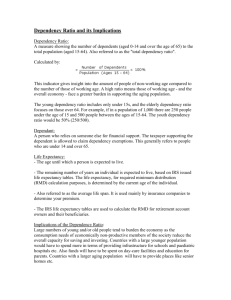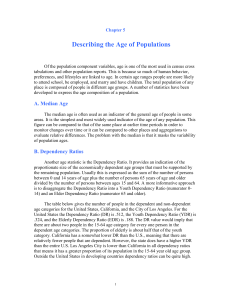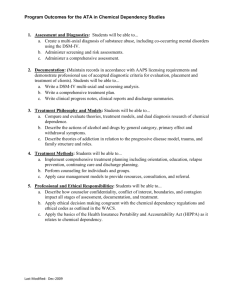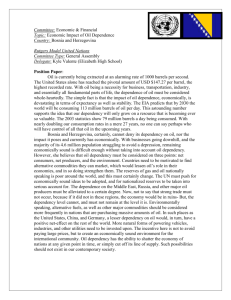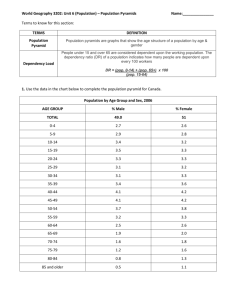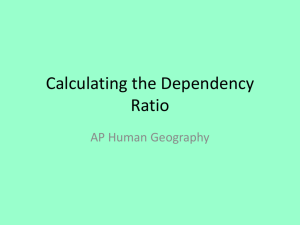Dependency Ratios for Census Workshop
advertisement
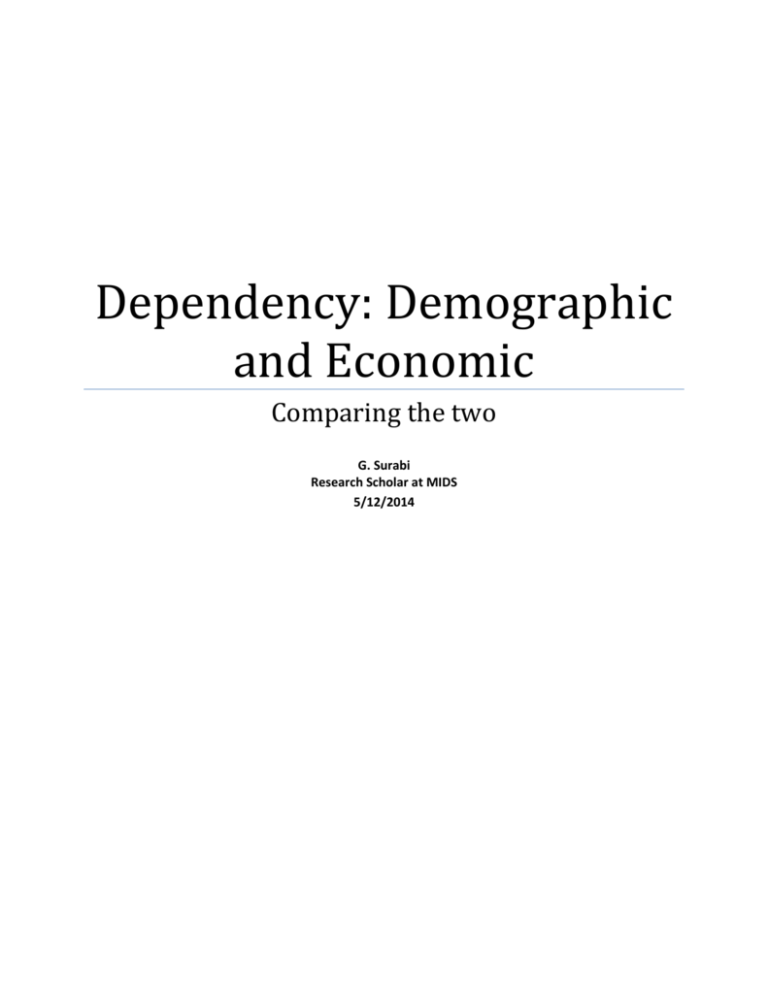
Dependency: Demographic and Economic Comparing the two G. Surabi Research Scholar at MIDS 5/12/2014 Table of Contents: Table of Contents: ......................................................................................................................................... 2 1. Introduction: ......................................................................................................................................... 3 2. Literature on Dependency ratio ............................................................................................................ 3 3. Need for the study: ............................................................................................................................... 4 4. Data and Methodology ......................................................................................................................... 4 5. Hypothesis: ........................................................................................................................................... 5 6. Definitions of various dependency ratios: ............................................................................................ 5 7. The population pyramid of India during 2001 and 2011: ..................................................................... 7 8. Dependency Ratio and Economic dependency ratio in various states: .............................................. 11 9. Regression Analysis: ............................................................................................................................ 13 EDR and DR ............................................................................................................................................. 13 EDR with OADR and YADR....................................................................................................................... 14 10. Some Recommendations: ............................................................................................................... 14 References: ................................................................................................................................................. 15 Appendix 1: Ageing Index ........................................................................................................................... 16 Appendix 2: OADR for India and States 2001 & 2011 ................................................................................. 17 Appendix 3: YADR of India and its States 2001 & 2011 .............................................................................. 18 Appendix 4: Dependency Ratio for India and its states: ............................................................................. 19 Appendix 5: EDR for India and its States 2001&2011 ................................................................................. 20 Appendix 6: OADR Descriptive statistics 2001 and 2011 ........................................................................... 21 Appendix 7: YADR Descriptive Statistics 2001 and 2011: ........................................................................... 22 Appendix 8: Regression Analysis................................................................................................................. 23 Regression 1: EDR with DR in 2001 ......................................................................................................... 23 Regression 2: EDR with DR in 2011 ......................................................................................................... 24 Regression 3: EDR with OADR and YADR 2001: ...................................................................................... 25 Regression 4: EDR with OADR and YADR 2011: ...................................................................................... 26 2 1. Introduction: The main idea behind this study is to capture the demographic dependency ratio1 that is done through calculating the old age dependency ratio2 and the young age dependency ratio3. Next is to capture the economic dependency ratio4 (EDR) that is done by calculating the ratio of the unemployed, the population below 14 and population above 60 to the total working population of the working age group 15-59. One main aim of this paper was to determine whether demographic dependency is the sole cause of economic dependency. This is analyzed using regression models that are discussed in the subsequent sections. The results indicate that demographic dependency explains only a part of the changes in economic dependency both in 2001 and 2011. 2. Literature on Dependency ratio The previous century was a period of demographic transition from high fertility and high mortality to a situation of low fertility and low mortality in developed and developing nations of the world. This has resulted in an increasing high proportion of elderly people in most of the developed and developing nations and the care for such elderly persons pose a challenge for social security measures in every government where old age dependency is high. (Harwood, Sayer, & Hirschfeld, 2004) Fertility decline over the past four to five decades is considered one of the major reasons for the ageing population at present in the developed and developing countries. As a result of fertility decline, a progressive decline has occurred in the proportion of younger population on which the future of the countries belongs and older population may turn for support. (Nations, 2002) As older population is on the increase their need for the daily care and health care also increases, as their health conditions are on the decline. There is a general consensus that the older population is on the increase in every part of the world and that differences in the growth rate are also increasing. Alternatively we can differentiate between the potential economic dependency ratio and the effective economic dependency ratio, where the former is the ratio of dependents (Popn. above 60 and Popn. 015) to the labour force population (15-59) and the latter is the ratio of dependents (young and old) to the employed persons in the labor force. The theory of demographic transition lists the five stages of growth rate of population. India is clearly in a late expanding stage where the birth rate is decreasing due to various policies and the death rate is also rapidly decreasing due to advances in medical facilities.(Lakshmamma & Kumari, 2013); Which signifies that the population pyramid is like a dome, as the one shown above? However such a 1 2 DR refers to Dependency ratio in this paper OADR refers to Old age dependency ratio in this paper. 3 YADR refers to Young age dependency ratio in this paper. 4 EDR refers to economic dependency ratio in this paper. 3 demographic bulge in the working group population must be accompanied by additional employment opportunities such that even the labor force does not contribute or add up to the problem of dependency. (Yusuf, Martins, & Swanson, 2014) . The concept of EDR is an evolving concept in the political debates around the world as it is considered to capture the real burden of dependency on the working population. (Titu, Banu, & Banu, 2012) This was used by the authors to study the EDR of Romania as a part of EU countries. Some authors compare potential economic dependency which is captured by the dependency ratio, and other authors calculate and compare the effective economic dependency as the pop 0-15 and the population above 60 by the active employed persons. (Titu, Banu, & Banu, 2012) Some authors calculate the economic dependency ratio in a different way, they include the ratio of economically inactive people (people under 14 and people above 60 and the unemployed in the 15-59 population) by the actively working population in 15-59 age group. Such an estimate takes the rate of dependency 5 to 6 times higher than that of the demographic dependency ratio. (Wöss, 2014) 3. Need for the study: The main objective of the study is to analyze and discuss the demographic indicators of various states of India particularly, the ageing index, dependency ratio, potential support ratio and also the economic dependency ratio. Such a study on dependency ratio and other related indices for all the states within India is minimal. The need for such a study is warranted by the differences in the states, their differences in development indices and also the differences in demographic and socio economic factors. 4. Data and Methodology The Data that has been used for this purpose has been derived mainly from the census data of the years 2001 and 2011 where the population of the various states under different age groups are available. Here the age group of 0-5 was not given, but as it was needed to calculate the young dependency ratio, the population of other age groups was deducted from the total population to calculate the born 0-5 age group population. The data for the working age group 15-59, older age group and young age group was tabulated for various states, from which the various indices like the ageing index and the dependency ratios – young age dependency ratio and the older dependency ratio have been calculated. 4 One more important calculation done is the economic dependency ratio which signifies the real burden of dependency on the working population of the 15-59 age groups. Next when we take the methodology we have regressed the economic dependency ratio with the dependency ratio first to determine the causation effect of economic dependency by the demographic dependency. Here the equation for the first regression where economic dependency ratio (EDR) is the dependent variable and the dependency ratio (DR) is the independent variable. We would have the equation as EDR = Constant + ß* DR + E This we calculate for both the years 2001 and 2011. Next we calculate the second set of regression where we have regressed the EDR with the young age dependency ratio and the old age dependency ratio as the independent variables. EDR = Constant + ß1 OADR+ß2 YADR+ E This regression is also calculated for the two census years 2001 and 2011. 5. Hypothesis: The hypothesis of this study is given as follows. H0= The EDR is minimally dependent on the DR, OADR and the YADR H1 = The EDR is more dependent on the DR, OADR and YADR. Thus we move on to define and calculate the above ratios and discuss the regression results as discussed in the methodology part. 6. Definitions of various dependency ratios: Dependency ratio by the name refers to the number of dependents to the number of working age population in a geographic area. There are various terms being used in the context of dependency ratio: Ageing Index Demographic Dependency ratio 1. Old age dependency ratio 2. Young age dependency ratio Economic dependency ratio Demographic dependency ratio is further classified into younger dependency ratio and older dependency ratio. The importance of determining various statistics as listed above is as follows: 5 Ageing Index is a ratio of the elderly persons above the age of 60+ who are economically inactive to the youngest population 0-14. Population ageing is an unprecedented but not an unnatural phenomenon given the improving health facilities that decreases the death rate and also the given decline in fertility rates due to changes in life style and increases women employment over the last two decades. (Lakshmamma & Kumari, 2013) It is calculated as 𝐴𝑔𝑒𝑖𝑛𝑔 𝑖𝑛𝑑𝑒𝑥 = (Population above 60 / Population 0-14) * 100 Although ageing index is a natural process due to fall in the birth rate and death rate due to advanced medical facilities, one important factor to be noted is that most of the developed countries have achieved or experienced slow process of ageing which the developing countries are experiencing in a much shorter time span which gives them much lower time for creation of productive employment. Total Dependency ratio is another index to measure the potential social support needs. It is assumed that population above 60 years and below 0-14 years are in some way dependent on the working age population of 15-60 years. Total dependency ratio = [(Population under 15 + population above 60) / population 15-59]*100 Here we differentiate between the younger dependency ratio and the older dependency ratio as follows The dependency ratio of a country or a geographical area is defined as the aggregate of number of children aged 0-15 and the number of persons above 60+ divided by the population in the working age group 15-60. Here we have two segregations. The older dependency ratio and The younger dependency ratio. The older dependency ratio is defined as the ratio of persons aged above 60 to the number of persons in the working age group 15-59. The younger dependency ratio is defined as the ratio of people aged 0 to 15 to the number of persons in the working age group 15-59. Old Age Dependency Ratio = (Population above 60) / (Pop. aged 15-59) Youth Dependency Ratio= (Population under 14) / (Pop. aged 15-59) The importance of dependency ratio lies in the fact that it is a rough indicator of burden of dependency. However not all the persons in the employment age group 15-59 are productively employed? And this requires an analysis of actively employed persons and calculation of economic dependency ratio. 6 An more reliable ratio for the determining the real burden on the work force is given by some authors which is the economic dependency ratio which measures the inactive persons (which includes the unemployed in the working age group, the young(0-14) and the old(above 60) dependent population to the actively employed persons in working age group 15-59. (Zamaro, Green, Tsouros, & Chiavon, 2008)The purpose of computing this ratio lies in the fact that economic dependency captures the real burden over the actively employed persons. However this is an evolving concept and has many statistical complexities. Since the above 60+ population also consists of actively employed persons and many of the working age group are part time workers doing along with their studies, the complexities involved in calculating EDR makes it difficult to compute. But here we have taken the simplest computation, which may have some limitations. The EDR we have considered in this paper is the ratio of the unemployed in 15-59 age groups, population above 60+ and population 0-14, to the actively employed main workers. The limitations in such an calculation may include excluding the persons employed in above 60+ age group, and excluding the part time and marginal workers, etc. 7. The population pyramid of India during 2001 and 2011: Before calculating the dependency ratio one needs to look at the population pyramid of India over the two census periods. In the bar charts below we can see the population pyramid of India in 2001 and 2011. We can see that Population pyramid-India 2001 A.N.S 80+ 70-79 60-69 50-59 40-49 35-39 30-34 25-29 20-24 15-19 10-14 5-9 0-5 Females Males 15 10 5 0 5 10 15 7 Population pyramid-India 2011 80+ 60-69 40-49 Females 30-34 Males 20-24 10-14 0-5 15 10 5 0 5 10 15 We can see from the population pyramid of India in the above two figures that the ageing population of India is on the increase and as such young population is also the highest in the age group 10-24. The above diagram clearly highlights that in the next two decades the old age dependency ratio will be higher and the social security policies should be directed towards that. But one cannot just conclude from just viewing the population pyramid of a country. There are many factors that must be considered. The ageing Index, OADR and YADR, DR and EDR are calculated for the various states of India and tabulated which are shown in Appendix 1,2,and 3. The highest ageing Index is found in Kerala in both 2001 and 2011 followed by Goa and Tamil Nadu. Appendix 1 and the chart below show the differences in ageing index in the various states where the states with highest ageing index would need more social security measures than the rest of the states. 8 Ageing Index 60.00 50.00 40.00 2001 30.00 2011 20.00 10.00 0.00 INDIA KERALA GOA TAMIL NADU When the ageing population of a region goes higher and higher as in the case of Kerala and Goa, their effects on the society is complex. There will be problems in social security measures that are being provided; health care measures that have to be improved to keep the ageing population under proper care. Old Age Dependency 25.00 20.00 2001Total Males 15.00 Females 10.00 2011 Total Males 5.00 Females 0.00 INDIA KERALA PUNJAB HIMACHAL PRADESH Old age dependency is highest in Kerala followed by Punjab and Himachal Pradesh. One important fact to be noted is that the old age dependency ratio is higher among females in Kerala both in 2001 and 9 2011. In Punjab and Haryana such a discrepancy is not noted. Some states exhibit such discrepancies among the male OADR and female OADR that necessitate more security measures for the female population above 60 years. When we look into the Young age dependency ratio which implies that the birth rate is still high in these states, Bihar leads with 82.16 in 2001 and 76.88 % in 2001; followed by Meghalaya and Uttar Pradesh. Young Age Dependency Ratio 90.00 80.00 70.00 60.00 50.00 40.00 30.00 20.00 10.00 0.00 2001 Total Males Females 2011 Total Males Females While the data on other states show the differences in OADR and YADR, the descriptive statistics show the maximum and minimum values of the two ratios, with the mean showing the average for India as a whole. This has been tabulated in Appendix 6 and 7. 10 8. Dependency Ratio and Economic dependency ratio in various states: The states with highest dependency ratio, which is the sum of old age dependency and also the young age dependency ratio are Bihar, Uttar Pradesh, Rajasthan and Meghalaya as shown in the chart below. States with highest dependency ratio 2001 95.1291.08 BIHAR 92.65 77.84 UTTAR PRADESH 2011 88.24 73.12 88.41 80.09 RAJASTHAN MEGHALAYA Though dependency ratio has declined over the decade in these states, it is still higher than the all India average of dependency ratio of 75.17 in 2001 and 65.24 in 2011. Economic Dependency Ratio 2001&2011 600.00 500.00 400.00 300.00 2001 200.00 2011 100.00 0.00 LAKSHADWEEP UTTAR PRADESH JHARKHAND BIHAR 11 The economic dependency ratio which includes the burden of the unemployed with the demographic dependents is the highest in Lakshadweep which is union territory, in the states, it was the highest in Uttar Pradesh in 2001 but now it is the highest in Bihar. There are remarkable differences in the demographic dependency ratio and the economic dependency ratio as the burden of the unemployed in the working age group also lies in the shoulders of the employed in the working age group. However in the calculation of EDR only main workers are included, if marginal workers and part time workers are also included, the EDR might demonstrate lower values of economic dependency. One more disadvantage of DR and EDR is that not all the persons in the above 60 population category are unemployed. In fact they continue to earn and support their immediate off springs even in their old age. And even in the young population, under 14 categories, there are child laborers, even though there are policies against it. The population pyramid below shows the actual EDR in India, during 2001 and 2011. Population pyramid 2001 80+ 60-69 Male workers 40-49 Dependent males 30-34 Female workers 20-24 Dependant females 10-14 0-5 15 10 5 0 5 10 15 12 Population pyramid 2011 80+ 60-69 40-49 Male Workers 30-34 Dependant males Female Workers 20-24 Dependant females 10-14 0-5 15 10 5 0 5 10 15 However, the above pyramids, does not include the marginal workers and since most of the females tend to work in the marginal category and part time workers who work for 3 to 6 months, are not included, the EDR might decline or show much lower ratio if the marginal workers are included in the same. Still we can see that the 15-20 and 20-24 categories having a higher dependency as youth generally take up to 24 years to finish their studies and settle down. 9. Regression Analysis: The regression of economic dependency ratio by the dependency ratio gives the following results. EDR and DR (Economic dependency ratio and Dependency ratio) The regression equation as given by the regression run with EDR as the dependent variable and the DR as the independent variable is as follows EDR = Constant + ß* DR + E In 2001 it is given as EDR = 68.452 + 2.635(DR) + E Since R2 value is 0.218 the model does not sufficiently explain the changes in EDR due to changes in DR. Similarly in 2011, the equation has become as In 2011 EDR = -8.091 + 4.493(DR)+ E Here also the R2 value is given as 0.301, DR explains only 30% of the changes in the EDR. 13 EDR with OADR and YADR (Economic dependency ratio with Old Age dependency ratio and Young age dependency ratio) The regression results of EDR as the dependent variable and the OADR and YADR as independent variable in the years 2001 and 2011, gives the following results. Here the equation of EDR becomes EDR = Constant + ß1 OADR+ß2 YADR+ E In 2001, EDR= -0.462 + 10.258(OADR) +2.306(YADR)+E Here R2 value is given as 0.307, and the model only explains the 30.7% changes in EDR due to OADR and YADR. In 2011, EDR = -89.765+ 11.58(OADR) + 4.324 (YADR) Here R2 value is 0.362 which signifies that only 36.2% changes in EDR is explained by changes in OADR and YADR. However, the regression results of the above four regressions which are tabulated in appendix 8 have the R2 values that does not sufficiently explain the casual effects of changes in EDR due to changes in DR, OADR and YADR; which signifies that we have to accept the null hypothesis that Economic dependency is minimally related to demographic dependency (old age dependency ratio and young age dependency ratio). 10. Some Recommendations: As the various ratios indicate the increasing OADR and YADR in various states of India, the policy measures have to focus on providing Better pensions and social security measures for the 60+ population who are more dependent on their off springs in the working age group. Better health care facilities and discounts on medical treatments could be provided to the so called pensioners or the above 60+ age group. Already senior citizen allowances in railways and higher interest rates in banks for senior citizens are given in various banks. But the awareness that such facilities are being provided has to be created among the old population. Regarding YADR, the highest recorded YADR is in the lower developed states like Bihar and Utter Pradesh and hence better educational facilities and motivation to go to school has to be initiated and strengthened in these states. 14 As regards to EDR, the highest recorded is among the least developed which comes again to Bihar, Jharkhand and Uttar Pradesh. Better employment opportunities for the working age group has to be created in these states and others having higher EDR as the EDR is a much reliable indicator of economic dependency. Though there seems to be a correlation between YADR and EDR, one has to develop and handle the situation wholesomely such that all encompassing solution to the demographic bulge is tackled. Human population is now a day’s considered as a capital of a nation; one should educate and provide enough opportunities for the same to take the country to a higher level. References: Harwood, R. H., Sayer, A. A., & Hirschfeld, M. (2004). Current and future worldwide prevalence of dependency, its relation to total population and dependency ratios. Bulletin of World Health Organisation , 82 (4). Lakshmamma, T., & Kumari, P. (2013). Changing Age-structures of China, India & Japan - Concerns and Contributions. International Journal of Humanities and Social Science Invention . Nations, U. (2002). World Population Ageing. Depeartment of economic and 1950-2050;U N;2002, Social affair: Population division. Titu, M., Banu, I., & Banu, I.-M. (2012). Demographic and Economic Dependency Ratios – Present and Perspectives. International Journal of Economics and Finance , 4 (12). Wöss, D. J. (2014). The impact of labour markets on economic dependency ratios – Presentation of Dependency ratio calculator. http://www.oecd.org/eco/surveys/49314824.pdf: Chamber of Workers and Employees, Austria . Yusuf, F., Martins, J. M., & Swanson, D. A. (2014). Methods of Demographic Analysis. Springer. Zamaro, G., Green, G., Tsouros, A., & Chiavon, E. (2008). A new model dependency ratio for European cities. Italian Jouranl of Public Health . 15 Appendix 1: Ageing Index Ageing Index for India and States 2001 &2011 2001 INDIA 21.07 JAMMU & KASHMIR 18.67 HIMACHAL PRADESH 29.06 PUNJAB 28.77 CHANDIGARH 17.20 UTTARANCHAL 21.20 HARYANA 20.90 DELHI 16.02 RAJASTHAN 16.90 UTTAR PRADESH 17.15 BIHAR 15.77 SIKKIM 15.37 ARUNACHAL PRADESH 11.27 NAGALAND 12.40 MANIPUR (Excl. 3 Sub-divisions) 20.58 MIZORAM 15.63 TRIPURA 21.62 MEGHALAYA 10.78 ASSAM 15.65 WEST BENGAL 21.39 JHARKHAND 14.74 ORISSA 24.89 CHHATTISGARH 19.56 MADHYA PRADESH 18.41 GUJARAT 21.05 DAMAN & DIU 18.62 DADRA & NAGAR HAVELI 11.34 MAHARASHTRA 27.19 ANDHRA PRADESH 23.72 KARNATAKA 24.11 GOA 33.90 LAKSHADWEEP 17.98 KERALA 40.21 TAMIL NADU 32.96 PONDICHERRY 30.84 ANDAMAN & NICOBAR ISLANDS 16.69 2011 27.88 21.76 39.60 40.45 25.17 28.79 29.13 25.13 21.55 21.65 18.47 24.56 12.90 15.13 23.21 19.28 28.44 11.79 20.28 31.30 19.82 32.99 24.49 23.51 27.44 20.66 12.89 37.13 37.99 36.14 51.39 32.02 53.55 44.16 40.36 27.43 16 Appendix 2: OADR for India and States 2001 & 2011 Females Females 2011 Total Males Males 2001 Total 7.23 7.00 14.22 6.63 6.45 13.08 OADR INDIA 5.98 6.55 12.53 5.33 6.30 11.63 JAMMU & KASHMIR OADR 8.28 7.79 16.06 7.62 7.46 15.08 HIMACHAL PRADESH OADR 8.01 8.13 16.14 7.47 7.69 15.16 OADR PUNJAB 4.47 4.83 9.30 3.57 4.00 7.57 OADR CHANDIGARH 7.60 7.32 14.91 6.93 6.91 13.83 OADR UTTARANCHAL 7.09 6.98 14.07 6.63 6.68 13.31 OADR HARYANA 5.16 5.22 10.38 4.10 4.25 8.35 OADR DELHI 6.79 6.17 12.96 6.63 6.12 12.76 OADR RAJASTHAN 6.64 7.21 13.85 6.37 7.19 13.56 OADR UTTAR PRADESH 6.63 7.57 14.20 6.08 6.88 12.96 OADR BIHAR 4.54 5.58 10.12 3.94 5.11 9.05 OADR SIKKIM 3.69 4.02 7.71 3.89 4.37 8.26 ARUNACHAL PRADESHOADR 4.01 4.58 8.59 3.39 4.35 7.74 OADR NAGALAND 5.61 5.59 11.20 5.51 5.59 11.10 OADR MANIPUR (Excl. 3 Sub-divisions) 5.10 5.11 10.21 4.61 4.72 9.34 OADR MIZORAM 6.24 6.00 12.24 6.36 5.97 12.33 OADR TRIPURA 4.38 4.07 8.45 4.21 4.39 8.60 OADR MEGHALAYA 5.43 5.59 11.02 5.03 5.30 10.34 OADR ASSAM 6.63 6.56 13.19 6.11 5.84 11.95 OADR WEST BENGAL 6.31 6.35 12.65 5.41 5.38 10.79 OADR JHARKHAND 7.72 7.73 15.45 7.15 6.99 14.14 OADR ORISSA 7.02 6.05 13.07 7.02 5.94 12.96 OADR CHHATTISGARH 6.92 6.51 13.43 6.70 6.41 13.11 MADHYA PRADESH OADR 6.69 5.91 12.61 6.13 5.34 11.47 OADR GUJARAT 3.67 2.76 6.44 4.42 3.11 7.52 OADR DAMAN & DIU 3.40 2.87 6.27 3.69 2.90 6.59 OADR DADRA & NAGAR HAVELI 8.25 7.41 15.66 7.91 6.87 14.78 OADR MAHARASHTRA 8.14 7.27 15.40 6.60 6.01 12.61 ANDHRA PRADESH OADR 7.76 7.00 14.76 6.70 6.03 12.74 OADR KARNATAKA 9.15 7.62 16.77 6.98 5.54 12.51 OADR GOA 6.09 6.27 12.36 5.11 5.21 10.32 OADR LAKSHADWEEP 10.82 8.82 19.64 9.17 7.35 16.53 OADR KERALA 8.09 7.70 15.79 6.97 6.88 13.85 OADR TAMIL NADU 8.09 6.45 14.54 7.07 5.79 12.86 OADR PONDICHERRY 4.29 5.41 9.70 3.24 4.23 7.47 ISLANDS ANDAMAN & NICOBAROADR 17 Appendix 3: YADR of India and its States 2001 & 2011 Females Females 2011 Total Males Males 2001 Total 24.39 26.62 51.01 29.73 32.36 62.09 YADR INDIA 26.97 30.63 57.60 30.19 32.12 62.30 JAMMU & KASHMIR YADR 19.21 21.36 40.57 24.88 27.01 51.89 HIMACHAL PRADESH YADR 17.96 21.95 39.91 23.86 28.84 52.70 YADR PUNJAB 16.88 20.06 36.94 20.13 23.90 44.03 YADR CHANDIGARH 24.45 27.36 51.81 31.28 33.98 65.26 YADR UTTARANCHAL 21.80 26.48 48.28 29.10 34.60 63.70 YADR HARYANA 19.04 22.24 41.28 24.26 27.88 52.14 YADR DELHI 28.34 31.81 60.15 35.73 39.75 75.48 YADR RAJASTHAN 30.26 33.73 63.99 37.32 41.77 79.08 YADR UTTAR PRADESH 36.90 39.98 76.88 39.05 43.11 82.16 YADR BIHAR 20.26 20.94 41.20 28.96 29.90 58.86 YADR SIKKIM 29.54 30.25 59.79 35.92 37.38 73.30 ARUNACHAL PRADESHYADR 27.43 29.38 56.81 30.20 32.25 62.44 YADR NAGALAND 23.38 24.86 48.24 26.40 27.55 53.94 YADR MANIPUR (Excl. 3 Sub-divisions) 26.05 26.93 52.98 29.37 30.39 59.75 YADR MIZORAM 21.06 21.99 43.05 27.93 29.09 57.02 YADR TRIPURA 35.34 36.30 71.64 39.39 40.41 79.81 YADR MEGHALAYA 26.61 27.74 54.34 32.29 33.75 66.05 YADR ASSAM 20.62 21.54 42.15 27.25 28.58 55.84 YADR WEST BENGAL 31.09 32.76 63.85 35.56 37.67 73.22 YADR JHARKHAND 22.91 23.91 46.82 27.78 29.01 56.79 YADR ORISSA 26.29 27.08 53.37 32.62 33.64 66.27 YADR CHHATTISGARH 27.46 29.68 57.14 34.08 37.13 71.21 MADHYA PRADESH YADR 21.50 24.45 45.95 25.60 28.90 54.50 YADR GUJARAT 14.63 16.51 31.15 19.36 21.04 40.41 YADR DAMAN & DIU 23.22 25.42 48.65 28.44 29.67 58.11 YADR DADRA & NAGAR HAVELI 19.93 22.24 42.17 25.99 28.38 54.37 YADR MAHARASHTRA 19.70 20.85 40.55 25.97 27.20 53.17 ANDHRA PRADESH YADR 19.86 20.99 40.84 25.79 27.03 52.82 YADR KARNATAKA 15.80 16.83 32.64 17.98 18.94 36.92 YADR GOA 19.22 19.38 38.60 27.80 29.58 57.38 YADR LAKSHADWEEP 17.99 18.69 36.68 20.15 20.95 41.11 YADR KERALA 17.35 18.41 35.76 20.45 21.59 42.03 YADR TAMIL NADU 17.68 18.35 36.04 20.47 21.24 41.71 YADR PONDICHERRY 17.32 18.03 35.36 21.88 22.88 44.76 ISLANDS ANDAMAN & NICOBARYADR 18 Appendix 4: Dependency Ratio for India and its states: Dependency Ratio INDIA JAMMU & KASHMIR HIMACHAL PRADESH PUNJAB CHANDIGARH UTTARANCHAL HARYANA DELHI RAJASTHAN UTTAR PRADESH BIHAR SIKKIM ARUNACHAL PRADESH NAGALAND MANIPUR (Excl. 3 Subdivisions) MIZORAM TRIPURA MEGHALAYA ASSAM WEST BENGAL JHARKHAND ORISSA CHHATTISGARH MADHYA PRADESH GUJARAT DAMAN & DIU DADRA & NAGAR HAVELI MAHARASHTRA ANDHRA PRADESH KARNATAKA GOA LAKSHADWEEP KERALA TAMIL NADU PONDICHERRY ANDAMAN & NICOBAR ISLANDS DR DR DR DR DR DR DR DR DR DR DR DR DR DR 2001 75.17 73.93 66.97 67.86 51.60 79.09 77.01 60.49 88.24 92.65 95.12 67.90 81.56 70.18 2011 65.24 70.13 56.64 56.06 46.23 66.72 62.35 51.66 73.12 77.84 91.08 51.32 67.50 65.40 DR DR DR DR DR DR DR DR DR DR DR DR DR DR DR DR DR DR DR DR DR 65.05 69.09 69.35 88.41 76.38 67.78 84.02 70.93 79.23 84.32 65.98 47.93 64.70 69.15 65.78 65.56 49.43 67.70 57.63 55.88 54.57 59.44 63.19 55.29 80.09 65.37 55.35 76.50 62.27 66.44 70.58 58.55 37.58 54.91 57.83 55.95 55.61 49.41 50.97 56.33 51.55 50.58 DR 52.23 45.06 19 Appendix 5: EDR for India and its States 2001&2011 EDR INDIA EDR JAMMU & KASHMIR HIMACHAL PRADESH EDR EDR PUNJAB EDR CHANDIGARH EDR UTTARANCHAL EDR HARYANA EDR DELHI EDR RAJASTHAN EDR UTTAR PRADESH EDR BIHAR EDR SIKKIM ARUNACHAL PRADESH EDR EDR NAGALAND EDR MANIPUR (Excl. 3 Sub-divisions) EDR MIZORAM EDR TRIPURA EDR MEGHALAYA EDR ASSAM EDR WEST BENGAL EDR JHARKHAND EDR ORISSA EDR CHHATTISGARH EDR MADHYA PRADESH EDR GUJARAT EDR DAMAN & DIU DADRA & NAGAR HAVELIEDR EDR MAHARASHTRA EDR ANDHRA PRADESH EDR KARNATAKA EDR GOA EDR LAKSHADWEEP EDR KERALA EDR TAMIL NADU EDR PONDICHERRY EDR ANDAMAN & NICOBAR ISLANDS 2001 263.84 333.76 243.04 244.90 184.26 305.05 265.50 234.82 254.71 385.92 349.69 179.54 188.11 218.07 268.02 164.71 286.41 241.96 313.90 279.03 359.60 327.04 226.13 250.60 219.23 143.24 142.14 206.43 191.30 200.91 234.86 434.04 316.64 190.75 226.41 227.81 2011 271.85 416.77 266.72 267.51 185.29 292.73 294.11 233.57 256.54 419.98 466.23 187.83 213.80 196.31 226.42 186.90 271.27 253.98 296.70 286.91 434.50 334.51 238.60 255.72 223.10 115.13 174.89 186.51 184.32 188.64 230.47 516.57 291.49 187.81 231.58 218.92 20 Appendix 6: OADR Descriptive statistics 2001 and 2011 2001 Total OADR Mean 11.56312006 Standard Error 0.430685975 Median 12.42132169 Mode #N/A Standard Deviation 2.58411585 Sample Variance 6.677654727 Kurtosis -0.852711321 Skewness -0.320673251 Range 9.940642477 Minimum 6.586754749 Maximum 16.52739723 Sum 416.2723221 Count 36 2011 Total OADR Mean 12.66459 Standard Error 0.509515 Median 13.01475 Mode #N/A Standard Deviation3.057091 Sample Variance 9.345806 Kurtosis -0.1686 Skewness -0.26749 Range 13.37571 Minimum 6.268048 Maximum 19.64375 Sum 455.9252 Count 36 OADR Males OADR Females 5.710550133 5.85256993 0.201548294 0.24434976 5.888149345 6.24448316 #N/A #N/A 1.209289764 1.46609858 1.462381733 2.14944505 -0.331692771 -0.6694498 -0.485514085 -0.16520361 4.789379525 5.93342942 2.901041745 3.24008552 7.69042127 9.17351494 205.5798048 210.692517 36 36 Males Females Females 6.222588 0.23495 6.398399 #N/A 1.409699 1.987252 0.317752 -0.689999 6.06341 2.760203 8.823613 224.0132 36 Mean 6.442001 Standard 0.285731Error Median 6.638757 Mode #N/A Standard 1.714385Deviation Sample 2.939115 Variance Kurtosis -0.16326 Skewness 0.097998 Range 7.421264 Minimum 3.398877 Maximum 10.82014 Sum 231.912 Count 36 21 Appendix 7: YADR Descriptive Statistics 2001 and 2011: 2001 Total Males Females Mean Standard Error Median Mode Standard Deviation Sample Variance Kurtosis Skewness Range Minimum Maximum Sum Count 58.4058 1.962005 57.20004 #N/A 11.77203 138.5807 -0.49707 0.1949 45.24314 36.91951 82.16265 2102.609 36 30.26208 1.023606 29.33498 #N/A 6.141636 37.71969 -0.39922 0.212757 24.17112 18.94027 43.1114 1089.435 36 28.14372 0.948932 27.86507 #N/A 5.69359 32.41696 -0.58089 0.180572 21.41513 17.97924 39.39437 1013.174 36 2011 Total Mean 47.89413 Standard Error 1.844286 Median 46.38289 Mode #N/A Standard Deviation 11.06571 Sample Variance 122.45 Kurtosis 0.072844 Skewness 0.728501 Range 45.73542 Minimum 31.14503 Maximum 76.88045 Sum 1724.189 Count 36 Males Females 24.8818 0.951957 24.17765 #N/A 5.711741 32.62399 0.019112 0.68389 23.47136 16.51024 39.9816 895.7447 36 23.01233 0.901768 21.65102 #N/A 5.410605 29.27465 0.111491 0.755423 22.26406 14.6348 36.89885 828.4438 36 22 Appendix 8: Regression Analysis Regression 1: EDR with DR in 2001 23 Regression 2: EDR with DR in 2011 24 Regression 3: EDR with OADR and YADR 2001: 25 Regression 4: EDR with OADR and YADR 2011: 26

